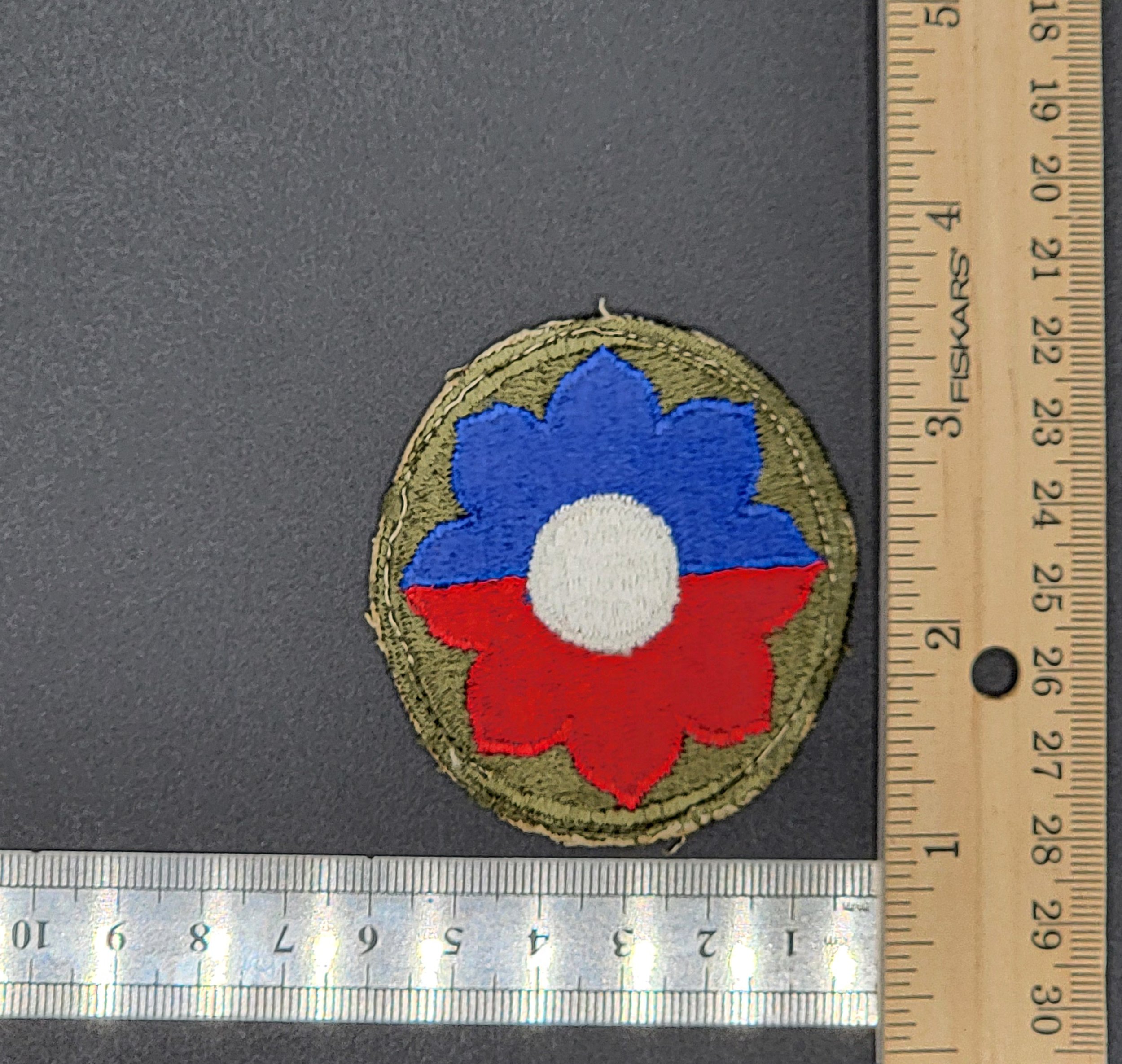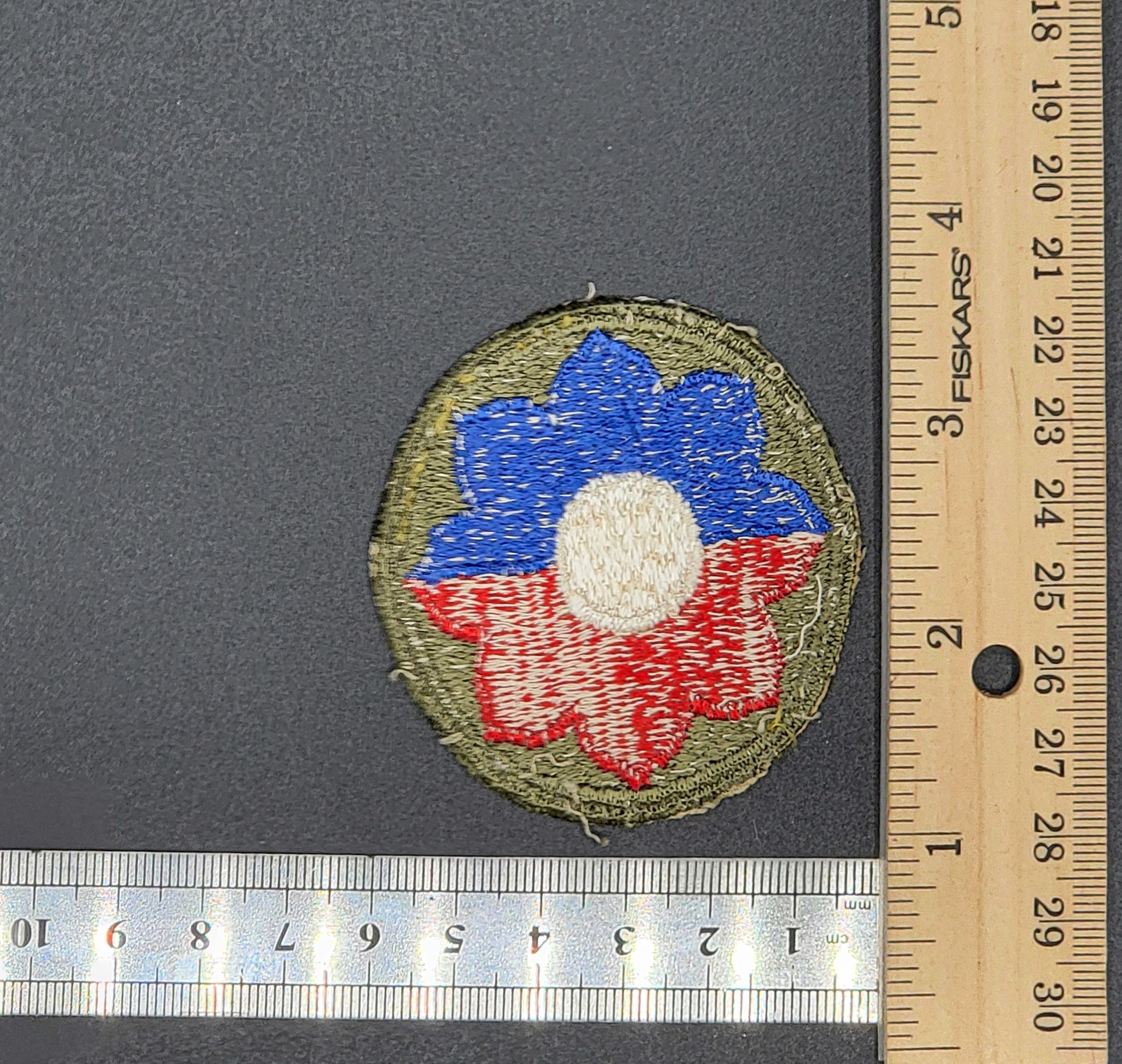9th Infantry Division
The 9th Infantry Division was among the first U.S. combat units to engage in offensive ground operations during World War II. (The others were the 32nd and the 41st in the Pacific on New Guinea, Carlson's Raiders on Makin Island, the 1st Marine, and the Americal on Guadalcanal, and, alongside the 9th in North Africa, were the 1st Infantry, 3rd Infantry, 34th Infantry and the 2nd Armored Divisions.) The 9th saw its first combat on 8 November 1942, when its elements landed at Algiers, Safi, and Port Lyautey, with the taking of Safi by the 3rd Battalion of the 47th Infantry Regiment standing as the first liberation of a city from Axis control in World War II.
With the collapse of French resistance on 11 November 1942, the division patrolled the Spanish Moroccan border. The 9th returned to Tunisia in February and engaged in small defensive actions and patrol activity. On 28 March 1943 it launched an attack in southern Tunisia and fought its way north into Bizerte, 7 May. In August, the 9th landed at Palermo, Sicily, and took part in the capture of Randazzo and Messina.
Sent to England for further training, the division landed on Utah Beach on 10 June 1944 (D-day plus 4), cut off the Cotentin Peninsula, drove on to Cherbourg Harbour and penetrated the port's heavy defenses.
Following a brief rest in July, the division took part in the St. Lo break-through and in August helped close the Falaise Gap. Turning east, the 9th crossed the Marne, 28 August, swept through Saarlautern,[6] and in November and December held defensive positions from Monschau to Losheim.
Moving north to Bergrath, Germany, it launched an attack toward the Roer river, 10 December, taking Echtz and Schlich. From mid-December through January 1945, the division held defensive positions from Kalterherberg to Elsenborn. On 30 January the division jumped off from Monschau in a drive across the Roer and to the Rhine, crossing at Remagen, 7 March.
After breaking out of the Remagen bridgehead, the 9th assisted in the sealing and clearing of the Ruhr Pocket, then moved 150 miles (240 km) east to Nordhausen, where it assisted in the liberation of the Mittelbau-Dora concentration camp, and attacked in the Harz Mountains, 14–20 April. On 21 April the Division relieved the 3d Armored Division along the Mulde River, near Dessau, and held that line until VE-day.
After the war, the Division moved south to Ingolstadt. The Division assumed control of the Dachau Concentration Camp in early July.
The 9th Infantry Division was among the first U.S. combat units to engage in offensive ground operations during World War II. (The others were the 32nd and the 41st in the Pacific on New Guinea, Carlson's Raiders on Makin Island, the 1st Marine, and the Americal on Guadalcanal, and, alongside the 9th in North Africa, were the 1st Infantry, 3rd Infantry, 34th Infantry and the 2nd Armored Divisions.) The 9th saw its first combat on 8 November 1942, when its elements landed at Algiers, Safi, and Port Lyautey, with the taking of Safi by the 3rd Battalion of the 47th Infantry Regiment standing as the first liberation of a city from Axis control in World War II.
With the collapse of French resistance on 11 November 1942, the division patrolled the Spanish Moroccan border. The 9th returned to Tunisia in February and engaged in small defensive actions and patrol activity. On 28 March 1943 it launched an attack in southern Tunisia and fought its way north into Bizerte, 7 May. In August, the 9th landed at Palermo, Sicily, and took part in the capture of Randazzo and Messina.
Sent to England for further training, the division landed on Utah Beach on 10 June 1944 (D-day plus 4), cut off the Cotentin Peninsula, drove on to Cherbourg Harbour and penetrated the port's heavy defenses.
Following a brief rest in July, the division took part in the St. Lo break-through and in August helped close the Falaise Gap. Turning east, the 9th crossed the Marne, 28 August, swept through Saarlautern,[6] and in November and December held defensive positions from Monschau to Losheim.
Moving north to Bergrath, Germany, it launched an attack toward the Roer river, 10 December, taking Echtz and Schlich. From mid-December through January 1945, the division held defensive positions from Kalterherberg to Elsenborn. On 30 January the division jumped off from Monschau in a drive across the Roer and to the Rhine, crossing at Remagen, 7 March.
After breaking out of the Remagen bridgehead, the 9th assisted in the sealing and clearing of the Ruhr Pocket, then moved 150 miles (240 km) east to Nordhausen, where it assisted in the liberation of the Mittelbau-Dora concentration camp, and attacked in the Harz Mountains, 14–20 April. On 21 April the Division relieved the 3d Armored Division along the Mulde River, near Dessau, and held that line until VE-day.
After the war, the Division moved south to Ingolstadt. The Division assumed control of the Dachau Concentration Camp in early July.
The 9th Infantry Division was among the first U.S. combat units to engage in offensive ground operations during World War II. (The others were the 32nd and the 41st in the Pacific on New Guinea, Carlson's Raiders on Makin Island, the 1st Marine, and the Americal on Guadalcanal, and, alongside the 9th in North Africa, were the 1st Infantry, 3rd Infantry, 34th Infantry and the 2nd Armored Divisions.) The 9th saw its first combat on 8 November 1942, when its elements landed at Algiers, Safi, and Port Lyautey, with the taking of Safi by the 3rd Battalion of the 47th Infantry Regiment standing as the first liberation of a city from Axis control in World War II.
With the collapse of French resistance on 11 November 1942, the division patrolled the Spanish Moroccan border. The 9th returned to Tunisia in February and engaged in small defensive actions and patrol activity. On 28 March 1943 it launched an attack in southern Tunisia and fought its way north into Bizerte, 7 May. In August, the 9th landed at Palermo, Sicily, and took part in the capture of Randazzo and Messina.
Sent to England for further training, the division landed on Utah Beach on 10 June 1944 (D-day plus 4), cut off the Cotentin Peninsula, drove on to Cherbourg Harbour and penetrated the port's heavy defenses.
Following a brief rest in July, the division took part in the St. Lo break-through and in August helped close the Falaise Gap. Turning east, the 9th crossed the Marne, 28 August, swept through Saarlautern,[6] and in November and December held defensive positions from Monschau to Losheim.
Moving north to Bergrath, Germany, it launched an attack toward the Roer river, 10 December, taking Echtz and Schlich. From mid-December through January 1945, the division held defensive positions from Kalterherberg to Elsenborn. On 30 January the division jumped off from Monschau in a drive across the Roer and to the Rhine, crossing at Remagen, 7 March.
After breaking out of the Remagen bridgehead, the 9th assisted in the sealing and clearing of the Ruhr Pocket, then moved 150 miles (240 km) east to Nordhausen, where it assisted in the liberation of the Mittelbau-Dora concentration camp, and attacked in the Harz Mountains, 14–20 April. On 21 April the Division relieved the 3d Armored Division along the Mulde River, near Dessau, and held that line until VE-day.
After the war, the Division moved south to Ingolstadt. The Division assumed control of the Dachau Concentration Camp in early July.

